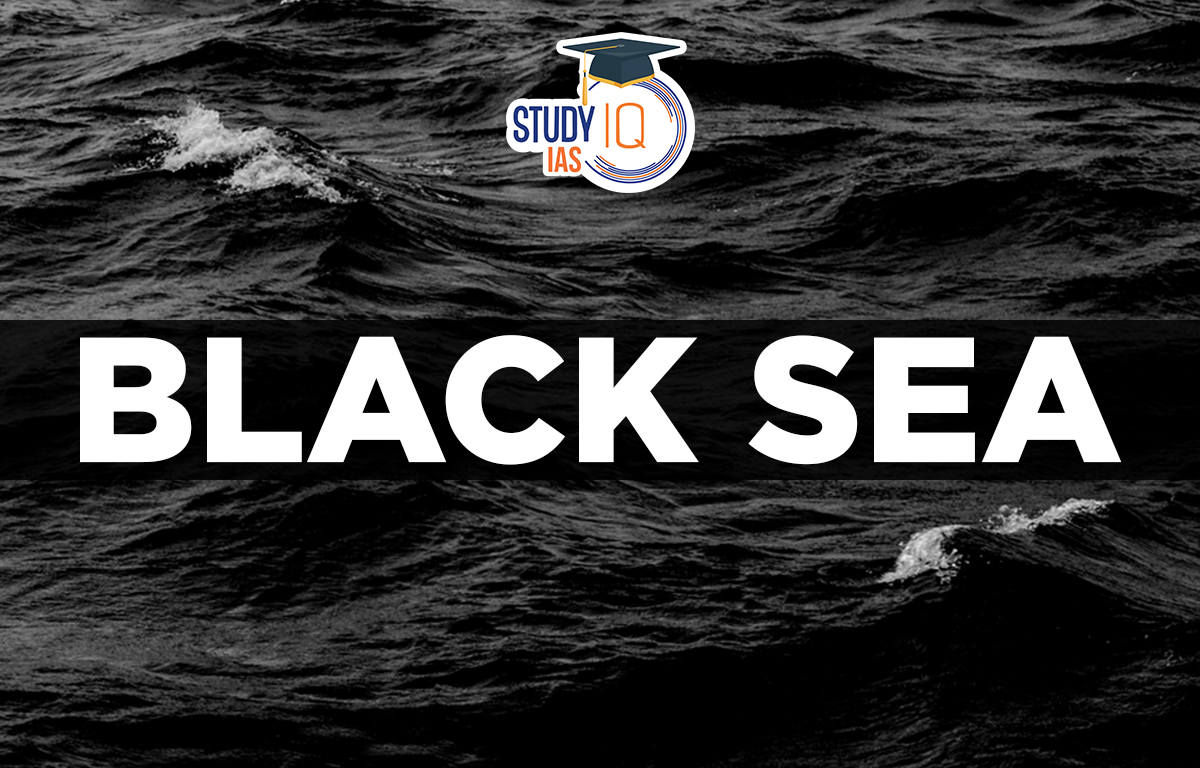Table of Contents
Black Sea
The Black Sea is an Atlantic Ocean outlying sea located between Europe and Asia. It is surrounded by Ukraine, Russia, Georgia, Turkey, Bulgaria, and Romania. The sea reaches a maximum depth of 7250 feet and covers an area of 422000 square kilometers. The Black Sea has been important for the culture and history of the nearby countries. For centuries, it has been a important route for trade and transportation with major ports along its shores. The sea also supports a rich ecosystem with unique marine life, including dolphins, whales, and sturgeons.
Read More: South China Sea
Black Sea Bordering Countries
Bordering Countries of the Black Sea are Turkey (Türkiye) to the south, Ukraine to the north, Russia to the northeast, Georgia to the east, and Bulgaria and Romania to the west.
Read about: Pacific Ocean
Black Sea Geography
Through the Turkish Straits and the Aegean Sea, the Black Sea eventually empties into the Mediterranean Sea. It is connected to the tiny Sea of Marmara by the Bosporus Strait, which is itself connected to the Aegean Sea by the Strait of the Dardanelles. The Kerch Strait connects the Black Sea to the Sea of Azov in the north. Black Sea salinity is extremely low as a result of massive freshwater inflow from rivers.
Read More: East China Sea
Black Sea Map
The Black Sea is bordered by six nations: Ukraine, Russia, Georgia, Turkey (Türkiye), Bulgaria, and Romania. With a surface area of 436400 km², the Black Sea (excluding the Sea of Azov) is somewhat larger than Germany or the US state of California.
Black Sea as a Meromictic Basin
The Black Sea is the largest meromictic body of water in the world, meaning its water layers do not mix. The upper layers get oxygen from the air but stay separate from the deeper waters. Because of this, over 90% of the deeper Black Sea is anoxic or lacking oxygen. Areas of seawater, freshwater, or groundwater that lack dissolved oxygen are referred to as anoxic waters. Therefore, the anoxic layer is to blame for the preservation of historic shipwrecks discovered in the Black Sea.
Read More: Sea of Okhotsk
Black Sea Physical Features
- The Black Sea’s shoreline is mostly mild, with steep cliffs only found in southern Crimea. The northern and western sides have low, deeply indented areas with many ravines and rivers.
- The eastern and southern shores are rugged and mountainous bordered by the Greater and Lesser Caucasus ranges and the Pontic Mountains.
- Near the Bosporus, the coastal relief becomes steeper, with low mountains in the Burgaski Bay area and the Bulgarian Balkan Mountains to the east.
- The largest islands in the Black Sea are Zmiyinyy (Fidonisi) in Ukraine and Berezan at the Dniester River estuary, with very few smaller islands.
- The sea has a shallow shelf that makes up about one-fourth of its area, typically less than 360 feet deep, and a chain of underwater mountains runs parallel to the coastline for about 100 miles.
Read More: Adriatic Sea
Black Sea Climate
The Black Sea is surrounded by land, giving it a continental climate, which means there are clear changes in temperature between seasons. In some areas around the sea, the local land features also affect the climate. In the region of the basin that is exposed to the impact of air masses from the north, there is a Steppe Climate with chilly winters and hot, dry summers. A humid subtropical climate with lots of Precipitation, warm winters, and humid summers characterises the southeast corner of the sea, which is protected by high mountains.
In winter, the northwest Black Sea cools down a lot, often forming ice because of cold, dry winds from the Siberian anticyclones. These strong northeasterly winds bring a drop in temperature and frequent rain, lasting about 185 days each year. As the air moves over the warmer eastern areas of the sea, it becomes warm and moist. Tropical air from the Mediterranean regions is always warm and humid (affected on 87 days on average). Winds from the Atlantic occasionally travel through eastern Europe and bring rain and violent squalls.
The sea’s core region experiences an average January air temperature of about 46 °F (8 °C), which drops to between 36 and 37 °F (2 and 3 °C) to the west. The average springtime air temperature is about 61 °F (16 °C), and the average summertime temperature is about 75 °F (24 °C). The hottest temperatures in the Black Sea region are in Crimea, sometimes reaching 99 °F (37 °C) in summer. The coldest temperatures are in the northwest, dropping to around 22 °F (-30 °C) during winter. Winter also brings the strongest winds, with hurricane-force winds hitting Novorossiysk, a Russian coastal area near the Kerch Strait, and strong winds on the sea itself.
Read More: Arabian Sea
Black Sea Economic Significance
The Black Sea serves as a important year-round transit route connecting eastern European nations with the global economy. Most of the sea’s freight traffic passes through the historic Ukrainian city of Odessa and the nearby port of Illichivsk. The ports of Novorossiysk and Tuapse in Russia, and Batumi in Georgia, are known for petroleum. In Bulgaria, the main ports are Varna and Burgas. Constanța in Romania connects oil-producing areas to international markets. Istanbul is Turkey’s main port on the Sea of Marmara, and the Danube River is an important trade route for the Balkan countries.
The Black Sea’s biological resource that is used the most is fish. Soviet authorities banned dolphin fishing in 1966. Other conservation and anti-pollution initiatives include limitations on oil tankers and the disposal of industrial trash. The Bucharest Convention, also known as the Bucharest Convention, was a comprehensive agreement to execute a number of extra programmes to manage pollution, preserve fisheries, and protect marine life. It was signed by the six Black Sea countries in the 1990s.
The Black Sea region is now a popular spot for relaxation and healing, thanks to its beautiful scenery and mineral springs, with Crimea being the main area for this. A growing number of tourists are drawn to the sandy beaches in Bulgaria and Romania.
Read More: Dead Sea
Black Sea UPSC
Black Sea serves as Eastern Europe’s entry point to the Mediterranean and to international shipping lanes. It connects Europe to the Middle East and the Caucasus. The area serves as a major hub for the global energy economy because of its hydrocarbon resources and transit system.
Read More: Caribbean Sea


 Desert Climate, Distribution, Climatic C...
Desert Climate, Distribution, Climatic C...
 Deserts of India Map, Features of Thar D...
Deserts of India Map, Features of Thar D...
 Indus Valley Civilization, History, Phas...
Indus Valley Civilization, History, Phas...





















